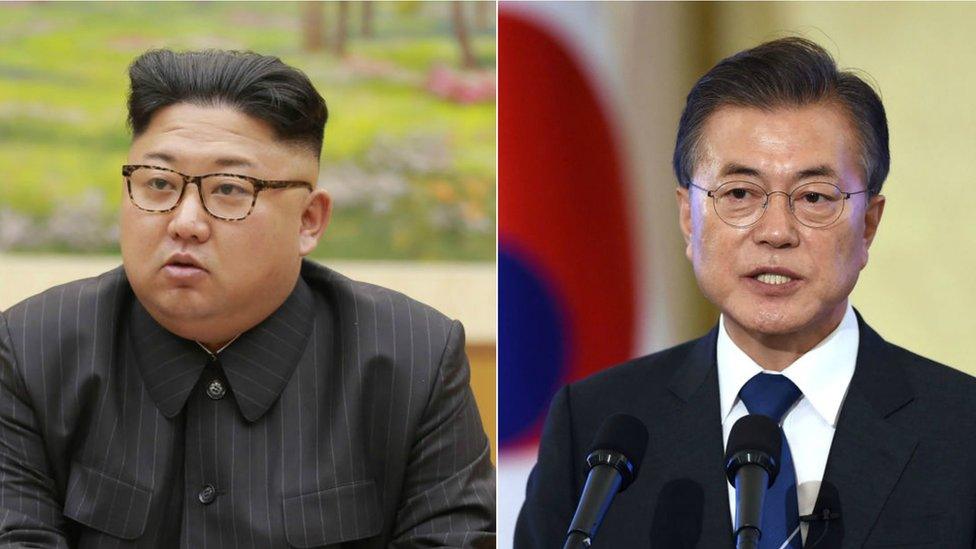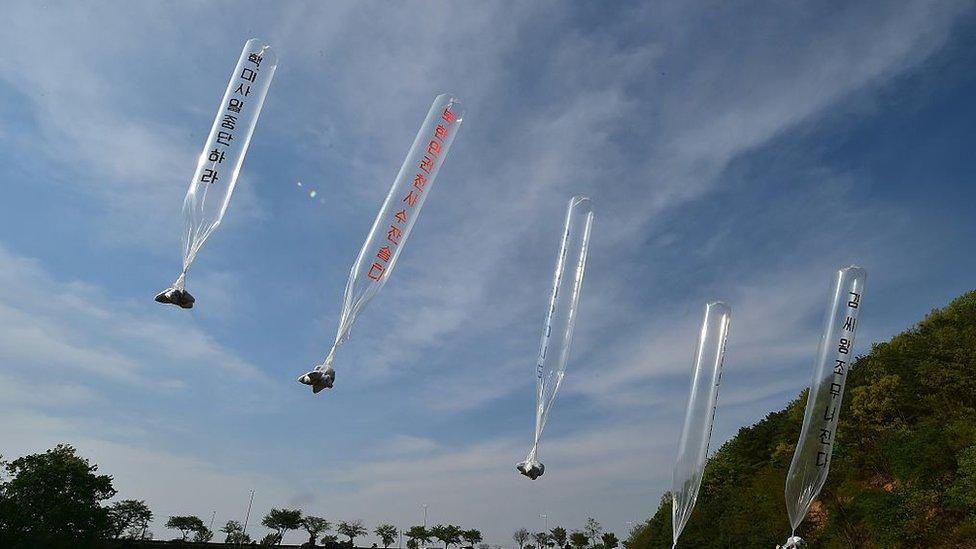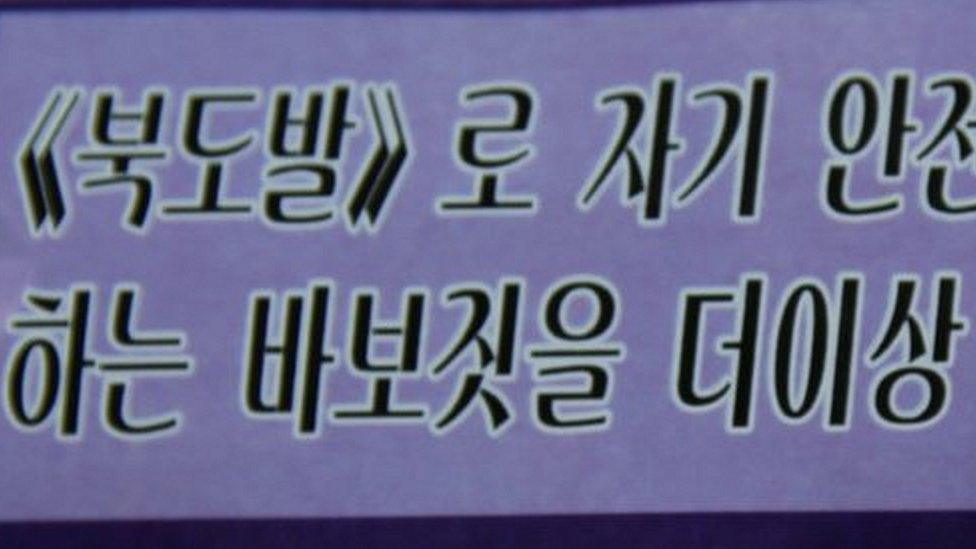North and South Korea: The petty side of diplomacy
- Published

Mr Kim and Mr Moon will soon come face-to-face at the inter-Korean summit, the first in a decade
North and South Korea are preparing for their first summit in just over a decade. After years of frosty relations and belligerent rhetoric, this is being hailed as a rare and hopeful moment by South Korean politicians.
As a peace treaty was never signed after the end of the Korean War in 1953, the neighbours do not have formal relations. The "Sunshine Policy" of re-engagement with the North from the late 1990s earned one leader a Nobel Peace prize, but broke down within a decade as South Korean politics changed course and Pyongyang pursued its illegal nuclear ambitions.
But over the years both North and South have also engaged in what some might see as miniscule acts of "petty" warfare designed to wind the other up but not cause lasting damage, almost reminiscent of some techniques used by the Soviet Union and the US during the Cold War.
"These kinds of displays provide an important competitive outlet between the two sides outside of possible military conflict," analyst Ankit Panda told the BBC.
"For both sides, I think what seems petty to us on the outside has important symbolic value and even operational effectiveness. The two countries are dramatically different in their ideologies and see value in exerting the primacy of their system of government."
These are some of the small-time point-scoring both sides have attempted over the years:
Loudspeakers
Both countries have been fighting an aural battle for years.
Before August 2015, the loudspeakers had been turned off for a couple of years, under a deal negotiated between both countries. But in 2015, after two South Korean soldiers were severely injured by North Korean-planted mines in the demilitarised zone (DMZ), the South turned its speakers back on.
It was halted again in 2015 and re-started in 2016 in response to the North's claim that it tested a hydrogen bomb.
But what exactly does South Korea broadcast from its speakers?

South and North Korea have turned these loudspeakers on and off at different points in their tumultuous relationship
You can expect to hear anything from weather reports, dramas, news from both Koreas that otherwise would not be heard over the border and even K-pop songs.
The loudspeakers are typically aimed at border guards, though they can also reach citizens that live near the DMZ border.
"The loudspeakers are left on all night and day and it hurts morale for some North Korea soldiers because some of them can't go to sleep, some are exhausted from hearing it all day," said Dr Kim. "So what North Korea is concerned about is the psychological impact of these broadcasts."
North Korea's broadcasts carry its characteristically strident condemnations of Seoul and its allies, but are said to be harder to hear - possibly the result of poor speakers.
But South Korea has now turned off its loudspeakers, just days after North Korea announced that it was stopping all its nuclear tests and launches of intercontinental ballistic missiles. The North appears to have stopped broadcasting propaganda too, residents on the southern side of the demarcation line say.
The South has not said whether it plans to restart the broadcasts once the summits are over.
Flagpole sizes
During the 1980s, the South Korean government built a 321.5-foot (97m) tall flagpole in its border village of Daesong-dong.
North Korea responded by building a 525-foot tall flagpole in its border town of Gijung-dong.

The North Korea flag in Gijung-dong can be seen here from the truce village of Panmunjom
"This is a good sign of one of them trying to one-up the other," Dr James Kim of the Asan Institute for Policy Studies told the BBC.
"That being said, it might have been very important to the North to build a bigger flagpole but South Korea might not even have really cared."
Balloon propaganda
Both the North and South have had a long history of launching propaganda balloons at each other.
In South Korea, defectors, conservatives and religious groups regularly launch these balloons, which can contain anything from leaflets to chocolate biscuits.

Both North and South send their own forms of propaganda through these balloons that can travel for miles
The balloons can go on to reach thousands of miles, and have been proven to be "very effective", according to Alex Gladstein, Chief Strategy Officer at Human Rights Foundation (HRF) who runs Flash Drives for Freedom, an initiative which sends flash drives in to North Korea.
HRF's flash drives contain anything from a selection of films, TV shows, documentaries and everyday footage of life in South Korea.
But the North themselves have also sent their fair share of balloons over to the South.
In 2016, hundreds of leaflets praising North Korea were found in Seoul, sent ahead of North Korea's 7th congress of its Workers Party, which was the first of its kind in 36 years.
Speculation arose then that Pyongyang may have sent the leaflets as part of its anti-South Korea psychological warfare.
But though the leaflets are unlikely to leave a great impact on South Korea, it could be more than just a matter of "pettiness" to North Korea.
"I've been in downtown Seoul and seen the propaganda leaflets a few times. It's interesting and novel for [South Koreans] but it isn't construed as something that is threatening to their daily livelihood," Dr Kim told the BBC.
"But for the North Koreans these pamphlets are very important. Ideology is very important to them, it's what keeps their regime together... so they might think that this is even more threatening to them than a small-scale military response."
Secret agents
In 2016, North Korea restarted its coded "numbers" broadcasting after a break of 16 years - a move which has angered South Korea.
Numbers broadcasts, as the name implies, usually comprise a series of numbers read out on air which will only make sense to someone with the decryption key, usually secret agents in a foreign country.
These apparent codes were observed in a late-night 12-minute section on Pyongyang Radio Station, a propaganda station aimed at South Korea.
Why the sudden resumption after 16 years?
The numbers broadcast comes almost immediately after the US and South Korea announced the deployment of a THAAD defensive missile battery in South Korea.
It's not clear if the move is a direct act of retaliation, but it's definitely got under the skin of South Korea, who urged the North to "desist from such practices."
The North and South's current relationship is arguably the closest the two neighbours have got in recent years.
But if the thaw does not turn into a permanent detente, more imaginative point-scoring is little short of certain.
BBC Monitoring, external contributed to this report
- Published12 January 2016

- Published19 April 2018

- Published28 March 2016
- Published19 January 2016
